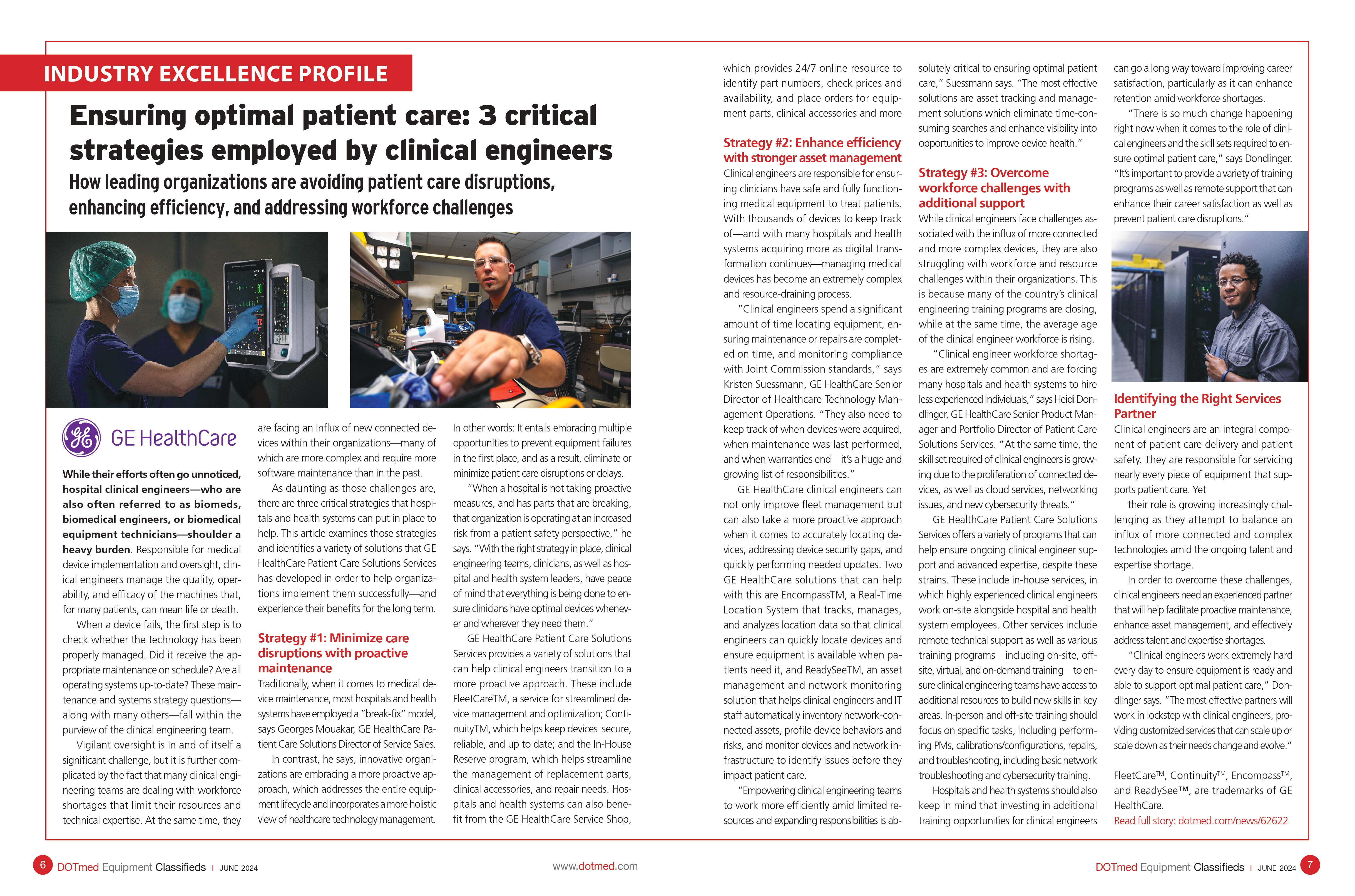While their efforts often go unnoticed, hospital clinical engineers—who are also often referred to as biomeds, biomedical engineers, or biomedical equipment technicians—shoulder a heavy burden. Responsible for medical device implementation and oversight, clinical engineers manage the quality, operability, and efficacy of the machines that, for many patients, can mean life or death.
When a device fails, the first step is to check whether the technology has been properly managed. Did it receive the appropriate maintenance on schedule? Are all operating systems up-to-date? These maintenance and systems strategy questions— along with many others—fall within the purview of the clinical engineering team.
Vigilant oversight is in and of itself a significant challenge, but it is further complicated by the fact that many clinical engineering teams are dealing with workforce shortages that limit their resources and technical expertise. At the same time, they are facing an influx of new connected devices within their organizations—many of which are more complex and require more software maintenance than in the past.
As daunting as those challenges are, there are three critical strategies that hospitals and health systems can put in place to help. This article examines those strategies and identifies a variety of solutions that GE HealthCare Patient Care Solutions Services has developed in order to help organizations implement them successfully—and experience their benefits for the long term.
Strategy #1: Minimize care disruptions with proactive maintenance
Traditionally, when it comes to medical device maintenance, most hospitals and health systems have employed a “break-fix” model, says Georges Mouakar, GE HealthCare Patient Care Solutions Director of Service Sales.
In contrast, he says, innovative organizations are embracing a more proactive approach, which addresses the entire equipment lifecycle and incorporates a more holistic view of healthcare technology management. In other words: It entails embracing multiple opportunities to prevent equipment failures in the first place, and as a result, eliminate or minimize patient care disruptions or delays.
“When a hospital is not taking proactive measures, and has parts that are breaking, that organization is operating at an increased risk from a patient safety perspective,” he says. “With the right strategy in place, clinical engineering teams, clinicians, as well as hospital and health system leaders, have peace of mind that everything is being done to ensure clinicians have optimal devices whenever and wherever they need them.”
GE HealthCare Patient Care Solutions Services provides a variety of solutions that can help clinical engineers transition to a more proactive approach. These include FleetCare™, a service for streamlined device management and optimization; Continuity™, which helps keep devices secure, reliable, and up to date; and the In-House Reserve program, which helps streamline the management of replacement parts, clinical accessories, and repair needs. Hospitals and health systems can also benefit from the GE HealthCare Service Shop, which provides 24/7 online resource to identify part numbers, check prices and availability, and place orders for equipment parts, clinical accessories and more
Strategy #2: Enhance efficiency with stronger asset management
Clinical engineers are responsible for ensuring clinicians have safe and fully functioning medical equipment to treat patients. With thousands of devices to keep track of—and with many hospitals and health systems acquiring more as digital transformation continues—managing medical devices has become an extremely complex and resource-draining process.
“Clinical engineers spend a significant amount of time locating equipment, ensuring maintenance or repairs are completed on time, and monitoring compliance with Joint Commission standards,” says Kristen Suessmann, GE HealthCare Senior Director of Healthcare Technology Management Operations. “They also need to keep track of when devices were acquired, when maintenance was last performed, and when warranties end—it’s a huge and growing list of responsibilities.”
GE HealthCare clinical engineers can not only improve fleet management but can also take a more proactive approach when it comes to accurately locating devices, addressing device security gaps, and quickly performing needed updates. Two GE HealthCare solutions that can help with this are Encompass™, a Real-Time Location System that tracks, manages, and analyzes location data so that clinical engineers can quickly locate devices and ensure equipment is available when patients need it, and ReadySee™, an asset management and network monitoring solution that helps clinical engineers and IT staff automatically inventory network-connected assets, profile device behaviors and risks, and monitor devices and network infrastructure to identify issues before they impact patient care.
“Empowering clinical engineering teams to work more efficiently amid limited resources and expanding responsibilities is absolutely critical to ensuring optimal patient care,” Suessmann says. “The most effective solutions are asset tracking and management solutions which eliminate time-consuming searches and enhance visibility into opportunities to improve device health.”
Strategy #3: Overcome workforce challenges with additional support
While clinical engineers face challenges associated with the influx of more connected and more complex devices, they are also struggling with workforce and resource challenges within their organizations. This is because many of the country’s clinical engineering training programs are closing, while at the same time, the average age of the clinical engineer workforce is rising.
“Clinical engineer workforce shortages are extremely common and are forcing many hospitals and health systems to hire less experienced individuals,” says Heidi Dondlinger, GE HealthCare Senior Product Manager and Portfolio Director of Patient Care Solutions Services. “At the same time, the skill set required of clinical engineers is growing due to the proliferation of connected devices, as well as cloud services, networking issues, and new cybersecurity threats.”
GE HealthCare Patient Care Solutions Services offers a variety of programs that can help ensure ongoing clinical engineer support and advanced expertise, despite these strains. These include in-house services, in which highly experienced clinical engineers work on-site alongside hospital and health system employees. Other services include remote technical support as well as various training programs—including on-site, offsite, virtual, and on-demand training—to ensure clinical engineering teams have access to additional resources to build new skills in key areas. In-person and off-site training should focus on specific tasks, including performing PMs, calibrations/configurations, repairs, and troubleshooting, including basic network troubleshooting and cybersecurity training.
Hospitals and health systems should also keep in mind that investing in additional training opportunities for clinical engineers can go a long way toward improving career satisfaction, particularly as it can enhance retention amid workforce shortages.
“There is so much change happening right now when it comes to the role of clinical engineers and the skill sets required to ensure optimal patient care,” says Dondlinger. “It’s important to provide a variety of training programs as well as remote support that can enhance their career satisfaction as well as prevent patient care disruptions.”
Identifying the Right Services Partner
Clinical engineers are an integral component of patient care delivery and patient safety. They are responsible for servicing nearly every piece of equipment that supports patient care. Yet their role is growing increasingly challenging as they attempt to balance an influx of more connected and complex technologies amid the ongoing talent and expertise shortage.
In order to overcome these challenges, clinical engineers need an experienced partner that will help facilitate proactive maintenance, enhance asset management, and effectively address talent and expertise shortages.
“Clinical engineers work extremely hard every day to ensure equipment is ready and able to support optimal patient care,” Dondlinger says. “The most effective partners will work in lockstep with clinical engineers, providing customized services that can scale up or scale down as their needs change and evolve.”
FleetCare™, Continuity™, Encompass™, and ReadySee™, are trademarks of GE HealthCare. Read full story: dotmed.com/news/62622









